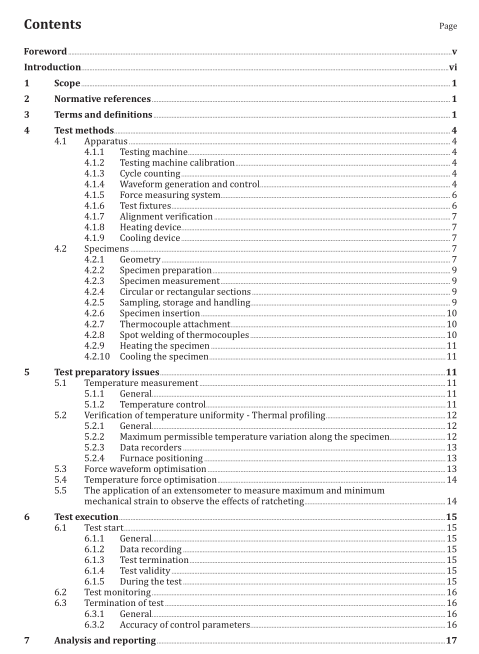ISO 23296:2022 pdf download.Metallic materials — Fatigue testing — Force controlled thermo-mechanical fatigue testing method
4 Test methods
4.1 Apparatus
4.1.1 Testing machine
The tests shall be carried out on a tension-compression machine designed for a smooth start-up. All test machines are used in conjunction with a computer or controller to control the test and log the data obtained. The test machine shall permit cycling to be carried out between predetermined limits of force to a specified waveform and for R < 0 tests there shall be no discernible backlash when passing through zero. In order to minimise the risk of buckling of the specimen, the machine should have great lateral rigidity and accurate alignment between the test space support references.
The machine force indicator shall be capable of displaying cyclic force maxima and minima for applied waveforms to a resolution consistent with the calibration requirement.
During elevated temperature tests the machine load cell shall be suitably shielded and/or cooled such that it remains within its temperature compensation range. Machines employing closed loop control systems for force and temperature shall be used.
4.1.2 Testing machine calibration
Machines shall be force calibrated to class 1 of ISO 7500-1. 4.1.3 Cycle counting The number of cycles applied to the specimen shall be recorded such that for tests lasting less than 10 000 cycles, individual cycles can be resolved, while for longer tests the resolution should be better than 0,01 % of indicated life.
4.1.4 Waveform generation and control
The force cycle waveform shall be maintained consistent and is to be applied at a fixed frequency throughout the duration of a test programme. The waveform generator in use shall have repeatability such that the variation in requested force levels between successive cycles is within the calibration tolerance of the test machine as stated in ISO 7500-1, for the duration of the test.
Terms have been identified relative to the trapezoidal waveforms in Figure 1 and Figure 2. Other waveform shapes may require further parameter definition although nomenclature should be retained where possible. Often, Force-controlled TMF loading waveforms do not follow standard trapezoidal patterns.
The phase angle between temperature and force is defined by the parameter Φ. Typical phase angles to characterize a TMF test are Φ = 0° which is called “in phase” and Φ = 180° which is called “out of phase”. Any other phase angle may be possible and permitted.
4.1.5 Force measuring system
The force measuring system, consisting of a load cell, amplifier and display, shall meet the requirements of ISO 7500-1 over the complete range of dynamic forces expected to occur during the TMF test series. The load cell should be rated for fully-reversed tension-compression fatigue testing. Its overload- capacity should be at least twice as high as the forces expected during the test. The load cell shall be temperature compensated and should not have a zero drift and temperature sensitivity variation greater than 0,002 % (Full scale/°C). During the test duration the load cell should be maintained within the range of temperature compensation and suitably protected from the heat applied during the test.
4.1.6 Test fixtures
An important consideration for specimen grips and fixtures is that they can be brought into good alignment consistently from test to test. Good alignment is achieved from very careful attention to design details, i.e. specifying the concentricity and parallelism of critical machined parts. In order to minimise bending strains the gripping system should be capable of alignment such that the major axis of the specimen coincides closely with the force axis throughout each stress cycle and in the case of through zero tests (Rε ≤ 0) shall also be free from backlash effects.
A parallelism error of less than 0,2 mm/m, and an axial error of less than 0,03 mm for a specimen of less than 300 mm in length, and of less than 0,1 mm for a test space of more than 300 mm in length, should allow the alignment requirements described in 4.1.7 to be achieved. A further benefit can be realised by minimising the number of mechanical interfaces in the load train and the distance between the machine actuator and crosshead.ISO 23296 pdf download.ISO 23296 pdf download
